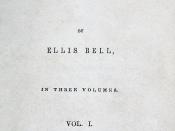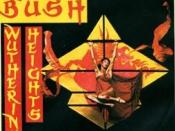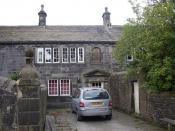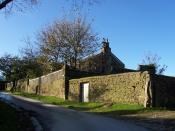The Heights, the Grange, and Their Inhabitants "Appearances can be deceiving."àThis clichÃÂéd proverb rings true at times, but in many cases is proven false. Through experience, a person discovers that an appearance reveals the true characteristics of a person or thing. Although one may find it shallow to link the outer physical qualities of a man to his inner being, it would also be ignorant to deny the relationship that exists between the exterior and interior of man. A person chooses how he looks, and because of his right to choose, his personality often leaks out through his appearance, even if he intended his appearance to represent a different personality than that of his true self. The characters found in the novel Wuthering Heights, by Emily BrontÃÂë, all prove that appearance is not deceiving. By analyzing these characters, a reader can also prove that a false appearance will betray the true identity of a person, for physical characteristics are nowhere near enough to cover up who the person has been all of his life.
The surroundings of a man also aids in interpreting his inner self. The way a person treats his belongings and especially where he chooses to live are all appearances that are associated with the person's character. Through the use of the physical descriptions of Wuthering Heights, Thrushcross Grange, and the characters of the novel, BrontÃÂë reveals the inhabitants' identities and relates them to the calm and stormy elements found throughout the novel.
In reality, weather cannot be controlled and therefore has no effect on human characteristics; however, by choosing to live in a specific environment, a person is often represented by the weather that surrounds him. Heathcliff, a character in the novel, lives the majority of his life at Wuthering Heights. This estate remained mostly dark and stormy; coincidentally (or not) these characteristics are also found in Heathcliff. Wuthering Heights, " "ÃÂWuthering' being a significant provincial adjective, descriptive of the atmospheric tumult to which its station is exposed in stormy weather"àwas located in the midst of rough winds that howl, proving that "pure, bracing ventilation must [be] up there at all times"à(BrontÃÂë 3). The occupier of this tempestuously weathered house did not differ much from what a reader might expect. Both representing the stormy elements of the novel, Wuthering Heights and Heathcliff are directly proportional; whatever characteristics the storm indicates, Heathcliff's characteristics shadow it. The winds predicted the stormy elements of not only Heathcliff, but of Catherine as well. Although Catherine was not as gloomy as the weather indicated, her wildness and passion proved her relationship with the intense winds. The fact that Catherine was "barefoot"àwhen running "from the top of the Heights to the park, without stopping"à(36) point out her wildness and strength, also ridding readers of the idea that she might be ladylike and distinguished. Thrushcross Grange on the other hand, was enclosed with beautiful weather. Completely opposing that of Wuthering Heights, the weather here was also directly proportional to its inhabitants. Edgar, the second man that Catherine fell in love with, was correctly described as calm and refined. Contrasting with Heathcliff, Edgar's weakness and frailness explain exactly why he resides at Thrushcross Grange and not at Wuthering Heights, for Edgar, the "doll"à(43), "cried for mama, at every turn"àand "trembled if a country lad heaved his fist against you"à(44). The weather about the two houses interact with the behaviors of its inhabitants, causing the storyline to separate into two forces of calmness and storminess, which reappears throughout the novel.
The houses' physical conditions work together with the inhabitants' looks, creating a connection between appearance and education. Society claims a well-kept, beautiful house customary, while a gloomy-looking house hidden in the dark is gossiped as strange, and even evil or haunted. In that same way, a well-kept and clean man would be normal, while a dirty, dark man is depicted as stormy and wild. Clearly, Wuthering Heights and Thrushcross Grange fall into these society-made categories, as do Heathcliff and Edgar. Wuthering Heights has "a quantity of grotesque carving lavished over the front"àand "large jutting stones"à(4). Heathcliff with his "black eyes [that] withdraw so suspiciously under their brows"à(3) shares the same expression as his house. Catherine even says herself that he is "black and cross"à(41). Skillfully built, Wuthering Heights had the capabilities of being beautiful. Sadly, it was not, just as Heathcliff was not educated. He had "ælost the benefit of his early education: continual hard work, begun soon and concluded late, had extinguished any curiosity he once possessed in pursuit of knowledge, and any love for books or learning. His childhood's sense of superiority, instilled into him by the favors of old Mr. Earnshaw, was faded away. (52) Later in the story, Heathcliff proves his capability of intelligence when he returns to Wuthering Heights after three years. Just as it is abnormal to appear filthy, lacking an education was portrayed in the same way. Heathcliff had previously "struggled long to keep up an equality with Catherine in her studies"ÃÂ; finally, he was just looked upon as "deficient in intellect"à(52). Totally contrasting Wuthering Heights, Thrushcross Grange is pleasant to the eye and regarded as normal. Naturally, Edgar's appearance is regarded the same way, as is his education. Intellect, wealth, and success established a clear connection with Edgar early in his life, resulting in the reward of Catherine's hand in marriage. The physical appearances of the two houses and of the two inhabitants are closely related to the inhabitants' education and society's view of them.
The interiors of the two houses oppose each other in a way similarly found in the stormy and calm emotions of Heathcliff and Edgar. Heathcliff and Catherine first discover the beauty of Thrushcross Grange when peeking into the window of the house. All the red and gold that decorated the room impressed Heathcliff: Both of us were able to look in by standing on the basement, and clinging to the ledge, and we saw - ah! It was beautiful "ÃÂ a splendid place carpeted with crimson, and crimson-covered chairs and tables, and a pure white ceiling bordered by gold, a shower of glass-drops hanging in silver chains from the center, and shimmering with little soft tapers. (36) The beauty of this house can be compared to the love that Edgar felt for Catherine. His love was simple, pure, and selfless, resisting any suspicion towards his actions and feelings. In contrast to the beautiful Thrushcross Grange, the unorganized and undecorated interior of Wuthering Heights makes it seem as if it belonged to a "homely, northern farmer"ÃÂ (4). Lockwood gives an example the interior of the house: Having approached this structure, I looked inside, and perceived it to be a singular sort of old-fashioned couch, very conveniently designed t obviate the necessity for every member of the family having a room to himself. In fact, it formed a little closet, and the ledge of a window, which it enclosed, served as a table. (15) Not only is it plain, the house is dimly lit, causing the house to appear gloomy even on the inside. Expectedly, Heathcliff's emotions are just as dark and gloomy as the heart of the house. In relation to the house, Heathcliff's love for Catherine is not as pure as Edgar's. Heathcliff's heart is filled with desire for revenge; this desire is consistent throughout the novel. Heathcliff's actions, such as killing a dog, prove to be odd as well. The two houses' interior do indeed resemble the actions and emotions of Heathcliff and Edgar; the two elements of the story come up once again.
The novel Wuthering Heights relates the physical appearances of Wuthering Heights, Thrushcross Grange, and the characters to the characters' actual personality. The author shows no efforts to deceive readers in any way. What one sees is what one gets. By doing this, BrontÃÂë subtly informs her readers of how she wants her characters to be, without actually listing the character traits in the book. The two elements of calm and storm are also revealed without simply stating the fact that there are two opposing elements in the novel. Wuthering Heights is proof that appearances are not always deceiving. Throughout the whole novel, every appearance has been an absolute representation of the character's true self. Even after Heathcliff changed his appearance, his personality still surfaced, despite his attempt of covering it up. Appearances reveal much more than what it is given credit for. One should always keep this in mind, and never assume that what one sees is wrong.
Works Cited BrontÃÂë, Emily. Wuthering Heights. New York: Book Essentials Promotions, 1994.





